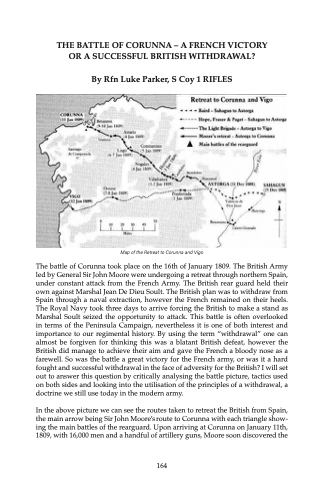Page 165 - Chronicle Vol 17
P. 165
THE BATTLE OF CORUNNA – A FRENCH VICTORY OR A SUCCESSFUL BRITISH WITHDRAWAL?
By Rfn Luke Parker, S Coy 1 RIFLES
Map of the Retreat to Corunna and Vigo
The battle of Corunna took place on the 16th of January 1809. The British Army led by General Sir John Moore were undergoing a retreat through northern Spain, under constant attack from the French Army. The British rear guard held their own against Marshal Jean De Dieu Soult. The British plan was to withdraw from Spain through a naval extraction, however the French remained on their heels. The Royal Navy took three days to arrive forcing the British to make a stand as Marshal Soult seized the opportunity to attack. This battle is often overlooked in terms of the Peninsula Campaign, nevertheless it is one of both interest and importance to our regimental history. By using the term “withdrawal” one can almost be forgiven for thinking this was a blatant British defeat, however the British did manage to achieve their aim and gave the French a bloody nose as a farewell. So was the battle a great victory for the French army, or was it a hard fought and successful withdrawal in the face of adversity for the British? I will set out to answer this question by critically analysing the battle picture, tactics used on both sides and looking into the utilisation of the principles of a withdrawal, a doctrine we still use today in the modern army.
In the above picture we can see the routes taken to retreat the British from Spain, the main arrow being Sir John Moore’s route to Corunna with each triangle show- ing the main battles of the rearguard. Upon arriving at Corunna on January 11th, 1809, with 16,000 men and a handful of artillery guns, Moore soon discovered the
164


